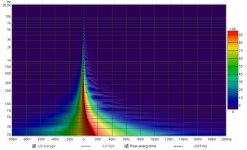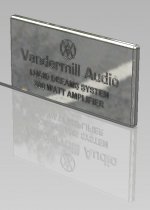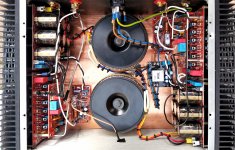I agree... tried it again today by first removing the mic-cal file and using (A * B) but it had the same result. As the mic trace stops at 10 Hz I figured that might have something to do with it. But that wasn't it. I couldn't find any reason for it in the Preferences either.
The difference in phase between the prediction and the JRiver virtual run seems to originate from the Microphone CAL file, which has an SPL column and a Phase column.
Not yet sure which of the two programs gets it right. I guess that would be JRiver and REW, as if I import the cal file into REW both phase and SPL carefully trace the numbers in the CAL file.
If I import that Mic data into RePhase and EQ the SPL curve flat, using minimum phase, the phase trace doesn't get corrected back to flat completely.
The difference in phase between the prediction and the JRiver virtual run seems to originate from the Microphone CAL file, which has an SPL column and a Phase column.
Not yet sure which of the two programs gets it right. I guess that would be JRiver and REW, as if I import the cal file into REW both phase and SPL carefully trace the numbers in the CAL file.
If I import that Mic data into RePhase and EQ the SPL curve flat, using minimum phase, the phase trace doesn't get corrected back to flat completely.
Weird there must be something different somewhere along the line because a simple multiplication shouldn't end up that far out.
My mic cal file only has frequency and level, no phase, works fine with both REW and DRC. DRC strips the phase from the cal file if you specify a minimum phase MCPoints file anyway.
REW (A*B level reduced) and DRC predictions are the same for me, I prefer the REW ones because the DRC spectrograms seem to lose all the fine data, like the FDW has been baked into it somehow. I should probably try and work out why that is too 🙂
My mic cal file only has frequency and level, no phase, works fine with both REW and DRC. DRC strips the phase from the cal file if you specify a minimum phase MCPoints file anyway.
REW (A*B level reduced) and DRC predictions are the same for me, I prefer the REW ones because the DRC spectrograms seem to lose all the fine data, like the FDW has been baked into it somehow. I should probably try and work out why that is too 🙂
Apparently Full Range and Line Aarray dont work:
(just when I have started my v2 build....oh crap 😉 )
YouTube - Using Full Range Drivers in a Line Array!?
(just when I have started my v2 build....oh crap 😉 )
YouTube - Using Full Range Drivers in a Line Array!?
Last edited:
Apparently Full Range and Line Aarray dont work:
(just when I have started my v2 build....oh crap 😉 )
YouTube - Using Full Range Drivers in a Line Array!?
ROFLMAO




Apparently he has never heard a Vifa based Line Array...
On a lighter note....
Is your son into Led Zep just as bad as you?
If so,
maybe he can learn the guitar and start a band with this girl... She rocks!
YouTube
She's awesome! Or are you trying to say that any child can play Bonzo's rhythms... 😀
ROFLMAO



Apparently he has never heard a Vifa based Line Array...
How can that be any good, the Vifa is not quite popular in this part of the forum.... 🙄
Apparently it is quite hard just to give them away....
Last edited:
Just watched the video, he's not that convinced by the CBT either, is he? 🙂
I could say a lot of things, but hey... I've already done that here, right?
To unsuspected viewers of this (my) topic: No, you can't just throw a bunch of fullrange drivers together in an enclosure and expect great things.
There's a little more to it than that alone. Luckily there is lots of info on this forum on how get better results and what to expect.
I just listened briefly this morning, it was horrible! 😀 That's why they are my main speakers for at least 4+ years in a row now. Just read the reviews:
Reviews are presented as links in post no. 1 of this thread
I could say a lot of things, but hey... I've already done that here, right?
To unsuspected viewers of this (my) topic: No, you can't just throw a bunch of fullrange drivers together in an enclosure and expect great things.
There's a little more to it than that alone. Luckily there is lots of info on this forum on how get better results and what to expect.
I just listened briefly this morning, it was horrible! 😀 That's why they are my main speakers for at least 4+ years in a row now. Just read the reviews:
Reviews are presented as links in post no. 1 of this thread
Last edited:
On to better things. As said, I wanted to revisit my multiple measurements and use my new way of processing on that. I finally got it ready for a listen.
This sounds promising, I won't go al lyrical about it just jet. I still have more to do. I think the averaging has quite a bit of advantages for these type of arrays.
It prevents over compensation for local dips/combing patterns.
Just don't use a very wide area to use for averaging. Don't go measuring along the whole couch etc.
What I have now are just 3 mic positions around ear positions. The whole goal of the previous measurements with the foam ball I've been doing was to get me in the ball park for my mid/side EQ compensation.
These two together, the averages + DSP and the mid/side EQ gets great results.
Disclaimer: I cannot stress enough that it does help (more than a great deal) to get rid of early reflections first, the old fashioned way... either by moving the speakers away from boundaries or using absorption/diffusion. I wanted my speakers relatively close to the wall, as this allows me to get more of a bottom end out of these tiny drivers. The front baffle of the array is only 0.5 Meter from the wall behind it. No treatment on that wall, not because I didn't want it, but simply because I couldn't.
But I do have treatment on the side wall's first reflection points. And a couple more based on measurements and placing damping panels throughout the room (like a lunatic). Yes, I did measure with damping panels on the wall behind the speakers too 😛. But hey, it's a living room, not a studio!
Not only arrays would benefit from room treatment. You won't believe the influence a room has until you have heard it yourself. Record your favorite speakers at the listening position. Listen to that recording on headphones, do you hear the room now? I bet you didn't hear it like that at the listening spot. Funny how our brain works. If that isn't enough yet, play that track on those same speakers, be careful though, it takes a lot of time to unlearn hearing that room from now on!
This sounds promising, I won't go al lyrical about it just jet. I still have more to do. I think the averaging has quite a bit of advantages for these type of arrays.
It prevents over compensation for local dips/combing patterns.
Just don't use a very wide area to use for averaging. Don't go measuring along the whole couch etc.
What I have now are just 3 mic positions around ear positions. The whole goal of the previous measurements with the foam ball I've been doing was to get me in the ball park for my mid/side EQ compensation.
These two together, the averages + DSP and the mid/side EQ gets great results.
Disclaimer: I cannot stress enough that it does help (more than a great deal) to get rid of early reflections first, the old fashioned way... either by moving the speakers away from boundaries or using absorption/diffusion. I wanted my speakers relatively close to the wall, as this allows me to get more of a bottom end out of these tiny drivers. The front baffle of the array is only 0.5 Meter from the wall behind it. No treatment on that wall, not because I didn't want it, but simply because I couldn't.
But I do have treatment on the side wall's first reflection points. And a couple more based on measurements and placing damping panels throughout the room (like a lunatic). Yes, I did measure with damping panels on the wall behind the speakers too 😛. But hey, it's a living room, not a studio!
Not only arrays would benefit from room treatment. You won't believe the influence a room has until you have heard it yourself. Record your favorite speakers at the listening position. Listen to that recording on headphones, do you hear the room now? I bet you didn't hear it like that at the listening spot. Funny how our brain works. If that isn't enough yet, play that track on those same speakers, be careful though, it takes a lot of time to unlearn hearing that room from now on!
It looks like you are flattening phase all the way to the bottom these days. Thinking back to development of my Synergies, does that represent a change in your thinking?
I really hesitate to dial in that much correction. I'm at 65K taps just to be able to correct magnitude at 20 Hz
Here's the final shape of my wavelet, it looks this nice and clean due to using a FDW filtered plot, but it does show I'm still very much a proponent for a band-pass behavior of phase following the frequency curve. The prior graphs were just the first steps before applying a low pass.
Attachments
Some few pages here now .... do you have a recent photo and description of the setup and how it looks now 😛
Not much has changed since this picture visually:

Except the amplifier seen in that picture has been replaced by this one:

It is a clone of a Goldmund Telos 400, about 350 watt into 8 ohm.
Source is the PC, A HP Z440 Workstation with E5 1650 V4 processor, 32 GB ram, Nvidia GTX 1070 for Home Theatre duties, and still the Asus Xonar Essence ST soundcard, feeding my Musical Fidelity M1 DAC trough SPDif optical.
Ambient channels are 2x Scan Speak 10F, powered by a Pioneer A447, connected to the Asus ST.
Jriver as the Media player and DSP center, correction created with a combination of REW, DRC-FIR and RePhase. Measurements with Behringer EMC8000, calibrated by ISEMcon (SPL and phase). Phantom power supplied by an IMG Stageline MPA-102.
Did I leave anything out? I don't think so...
Still in the works (didn't have enough time yet) 2x Subwoofer Scan Speak 30w/4558t00 each powered by a Hypex NC500MP.
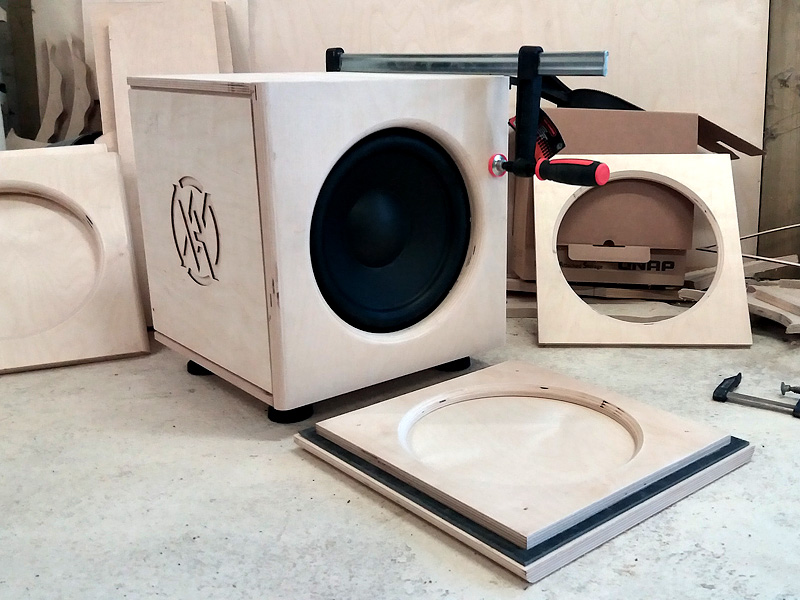
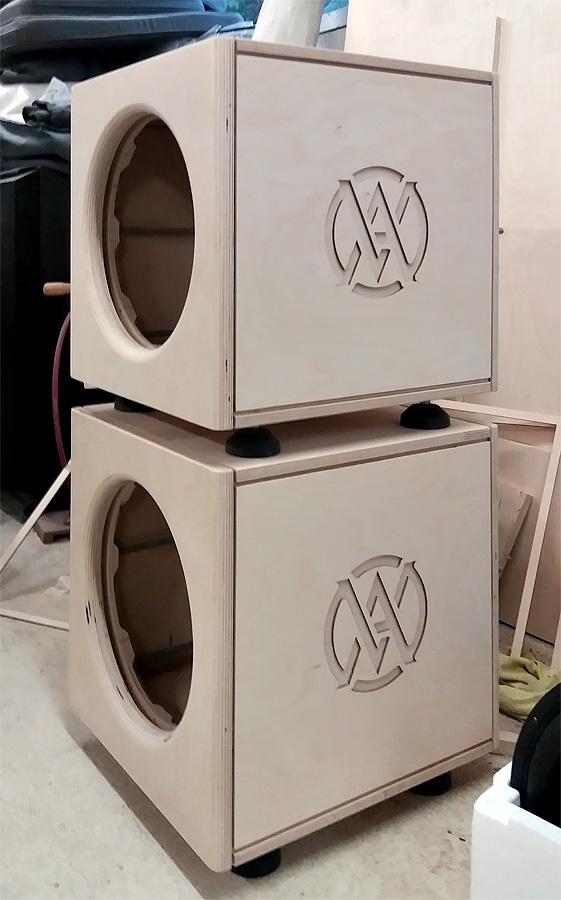
I still have to incorporate the power amp housing into the back of the sub enclosures after which I can give them a similar coating as the arrays (epoxy and boat paint). I have most of the stuff I need, just need to find the time to finish it. Still need to order a couple of parts. Been too busy with work and family life.
The current run of processing is in anticipation of integrating the subs as best I can.

Except the amplifier seen in that picture has been replaced by this one:

It is a clone of a Goldmund Telos 400, about 350 watt into 8 ohm.
Source is the PC, A HP Z440 Workstation with E5 1650 V4 processor, 32 GB ram, Nvidia GTX 1070 for Home Theatre duties, and still the Asus Xonar Essence ST soundcard, feeding my Musical Fidelity M1 DAC trough SPDif optical.
Ambient channels are 2x Scan Speak 10F, powered by a Pioneer A447, connected to the Asus ST.
Jriver as the Media player and DSP center, correction created with a combination of REW, DRC-FIR and RePhase. Measurements with Behringer EMC8000, calibrated by ISEMcon (SPL and phase). Phantom power supplied by an IMG Stageline MPA-102.
Did I leave anything out? I don't think so...
Still in the works (didn't have enough time yet) 2x Subwoofer Scan Speak 30w/4558t00 each powered by a Hypex NC500MP.
I still have to incorporate the power amp housing into the back of the sub enclosures after which I can give them a similar coating as the arrays (epoxy and boat paint). I have most of the stuff I need, just need to find the time to finish it. Still need to order a couple of parts. Been too busy with work and family life.
The current run of processing is in anticipation of integrating the subs as best I can.
Found a few hours(!) today to just sit and listen... had a good time doing just that. By the way, I ordered a few parts to see if I can finish up the subs before winter really sets in over here. 🙂
I listened to the Roger Waters - Amused to Death album as I was reminded on another thread what a great album that is. It is quite enjoyable with its QSound effects etc. Had to end the session with some 'Into The Electric Castle' though, I just felt like hearing that again. Not too long ago a Remastered version of that one came to market. In all honesty, I'll gladly take the original, any time, any day.
That actually happens with more remasters, sadly enough. I've been going through a Pink Floyd craze over the last few months and the remaster I've heard of Dark Side of the Moon also didn't float my boat. Sure it was crispy enough, but I love the original more.
I've even heard remasters where the songs were hardly recognisable, what's up with that? One of those was an old Black Sabbath album with Ronnie James Dio singing. It was like I was listening to a whole different album, but not a good one at that! I had to run to my collection and get a fix of the real thing.
Once every now and then a remaster does the original justice. Most worthy of mentioning would be the Zeppelin remasters. As I've said before, it was like going back to the vinyl sound I had been missing on the (huge amount of) CD's I had. I guess I have bought every album of them at least 5 times or so. Even have multiple vinyl versions of most of them. But it wasn't until those 24/96 Remasters (2014/2015?) came out that it felt like coming home for me.
Enough about remasters... I've done some very small overall balance tweaks that simply just work. Sometimes I'm amazed how a little tweak like that can make things so much better. I've said it a hundred times or more, but balance is everything. Unlike a lot of people I don't adjust between albums. I have a fixed level (independent from the source, thanks to JRiver) and seldom feel the need for specific tweaks. Before accepting tweaks I generally play a few different songs I have heard at least a thousand times or more to judge them, only then do I feel I can play whatever I like...
Some tweaking still ahead (mostly resetting the bass compensation between channels) and more listening time tomorrow. I look forward to it!
I listened to the Roger Waters - Amused to Death album as I was reminded on another thread what a great album that is. It is quite enjoyable with its QSound effects etc. Had to end the session with some 'Into The Electric Castle' though, I just felt like hearing that again. Not too long ago a Remastered version of that one came to market. In all honesty, I'll gladly take the original, any time, any day.
That actually happens with more remasters, sadly enough. I've been going through a Pink Floyd craze over the last few months and the remaster I've heard of Dark Side of the Moon also didn't float my boat. Sure it was crispy enough, but I love the original more.
I've even heard remasters where the songs were hardly recognisable, what's up with that? One of those was an old Black Sabbath album with Ronnie James Dio singing. It was like I was listening to a whole different album, but not a good one at that! I had to run to my collection and get a fix of the real thing.
Once every now and then a remaster does the original justice. Most worthy of mentioning would be the Zeppelin remasters. As I've said before, it was like going back to the vinyl sound I had been missing on the (huge amount of) CD's I had. I guess I have bought every album of them at least 5 times or so. Even have multiple vinyl versions of most of them. But it wasn't until those 24/96 Remasters (2014/2015?) came out that it felt like coming home for me.
Enough about remasters... I've done some very small overall balance tweaks that simply just work. Sometimes I'm amazed how a little tweak like that can make things so much better. I've said it a hundred times or more, but balance is everything. Unlike a lot of people I don't adjust between albums. I have a fixed level (independent from the source, thanks to JRiver) and seldom feel the need for specific tweaks. Before accepting tweaks I generally play a few different songs I have heard at least a thousand times or more to judge them, only then do I feel I can play whatever I like...
Some tweaking still ahead (mostly resetting the bass compensation between channels) and more listening time tomorrow. I look forward to it!
Thx for update, very appreciated 🙂
what is the Goldmund Telos 400 clone... I tried to google the name that seem to be on front plate but got no hits... is this something you built yourself, a kit, or something else?
The subs already look like real statement products, wow... cool 😛
Maybe you should send your tech drawings to Peter Lyngdorf 😀
Looks really really nice 🙂
what is the Goldmund Telos 400 clone... I tried to google the name that seem to be on front plate but got no hits... is this something you built yourself, a kit, or something else?
The subs already look like real statement products, wow... cool 😛
Maybe you should send your tech drawings to Peter Lyngdorf 😀
Looks really really nice 🙂
Last edited:
Not surprised you didn't find anything off of that logo...
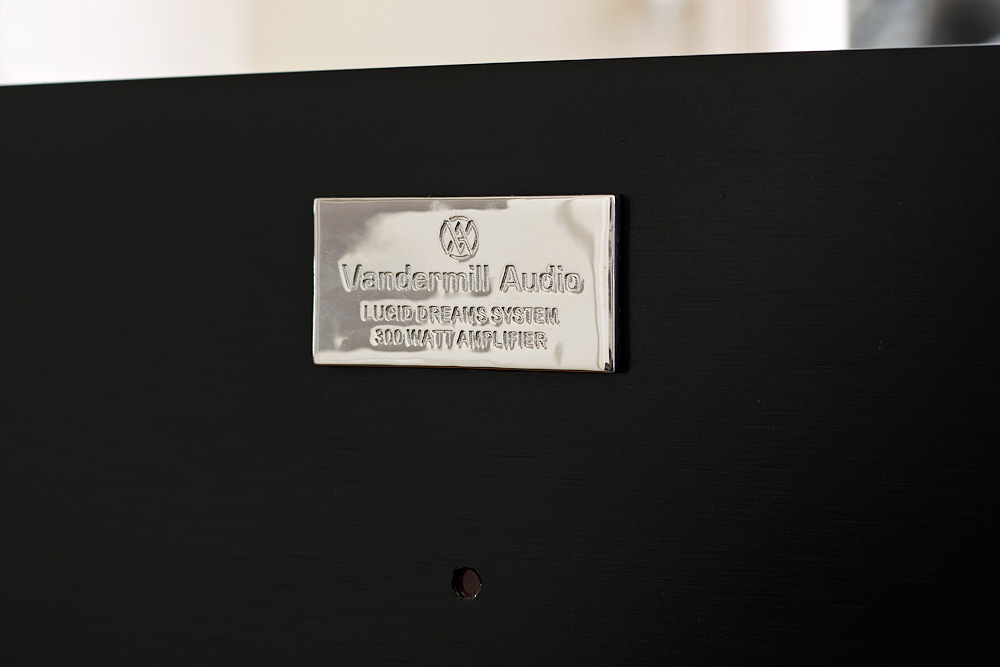
It is a badge I made to 'detail' the look of the amp, it's actually a 3D print:
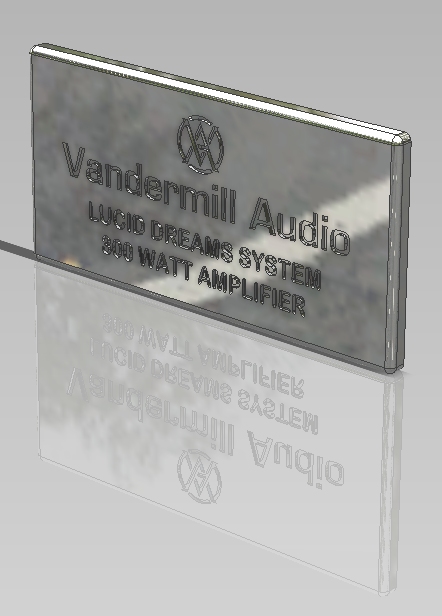
I designed a logo and stuck it on, it's the same logo as on the side of the sub enclosures. The "Lucid Dreams System" is my 'name' for the arrays and their listening result. Makes you dream while being awake... 😀
The amp was build by member koldby. He and BYRTT visited me some time ago and koldby had about 5 amplifiers with him to try with the arrays. I basically fell in love with the Goldmund clone and kept nagging koldby to sell it to me. The badge says 300 watt while the actual Goldmund Telos 400 it's based on is a 350 watt into 8 ohm load. It took me a while to find the specific model this amp was based on. It was clear it was a beast from the first time we heard it power the arrays.
It sports 12 mosfets per side, the same ones as in the original Goldmund amplifiers. A look inside:
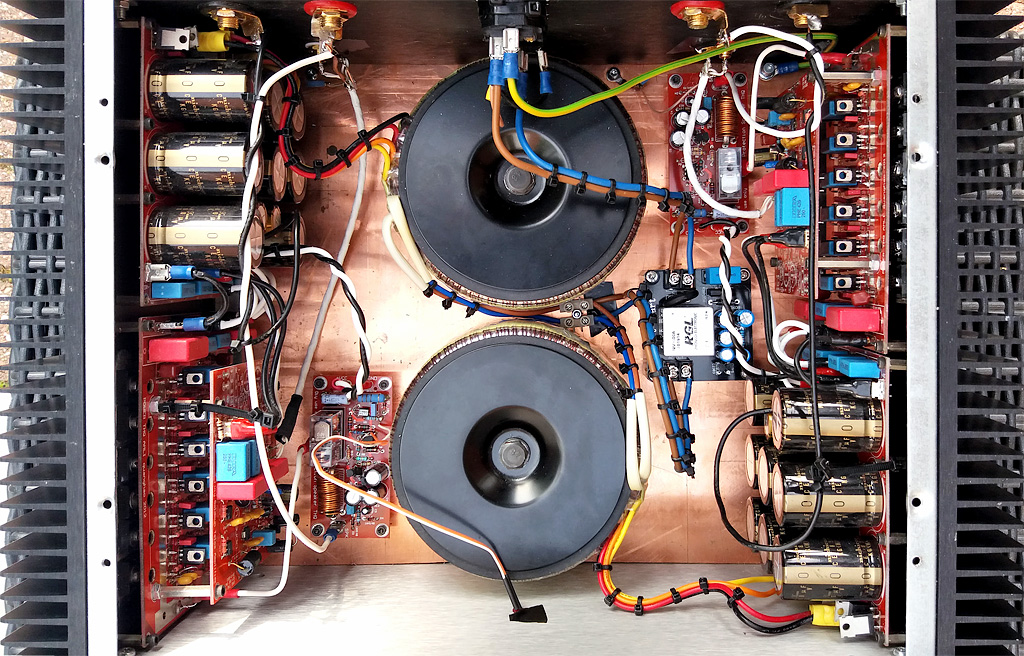
I looked towards the original Goldmund styling for inspiration, they always sport a gold logo. I asked koldby if I could do my own logo/badge on the front of this amp and figured I should use silver, well actually it's rhodium plated brass.
It is a badge I made to 'detail' the look of the amp, it's actually a 3D print:
I designed a logo and stuck it on, it's the same logo as on the side of the sub enclosures. The "Lucid Dreams System" is my 'name' for the arrays and their listening result. Makes you dream while being awake... 😀
The amp was build by member koldby. He and BYRTT visited me some time ago and koldby had about 5 amplifiers with him to try with the arrays. I basically fell in love with the Goldmund clone and kept nagging koldby to sell it to me. The badge says 300 watt while the actual Goldmund Telos 400 it's based on is a 350 watt into 8 ohm load. It took me a while to find the specific model this amp was based on. It was clear it was a beast from the first time we heard it power the arrays.
It sports 12 mosfets per side, the same ones as in the original Goldmund amplifiers. A look inside:
I looked towards the original Goldmund styling for inspiration, they always sport a gold logo. I asked koldby if I could do my own logo/badge on the front of this amp and figured I should use silver, well actually it's rhodium plated brass.
Attachments
Last edited:
@wesayso nice looking amp. Do I spy two power supplies?
Basically two mono-blocks in a single chassis...?
I also dislike most remasters lol.
I believe the (main) reason is due to the dynamic range compression commonly used.
With streaming radio or tv, they are moving away from that with the fairly new loudness standards (R128) . This will force most engineers to no longer destroy (squash) their mixes to be louder on the radio.
In fact since the db standard they sound much worse than uncompressed content.
RIP loudness war!!
I love your towers by the way.......
I just picked up 60 of the TC9's. Gonna try my hand at building some (corner) arrays similar to forum member "ra7".
Basically two mono-blocks in a single chassis...?
I also dislike most remasters lol.
I believe the (main) reason is due to the dynamic range compression commonly used.
With streaming radio or tv, they are moving away from that with the fairly new loudness standards (R128) . This will force most engineers to no longer destroy (squash) their mixes to be louder on the radio.
In fact since the db standard they sound much worse than uncompressed content.
RIP loudness war!!
I love your towers by the way.......
I just picked up 60 of the TC9's. Gonna try my hand at building some (corner) arrays similar to forum member "ra7".
You make commercial Audio Products look boring 😛
I think your attitude to music systems is great.... I never look for good sound, I look for that rig that can give me those magic moments and forget about time and place, and: makes you dream while being awake... 😀
I think your attitude to music systems is great.... I never look for good sound, I look for that rig that can give me those magic moments and forget about time and place, and: makes you dream while being awake... 😀
Yes, correct, its a dual mono in one chassis. That should explain why it had better channel separation than my previous amp, that worked a little different. Although that one also had 2 power supplies, it wasn't used as a separation between left and right channel.
So another array build about to start! Hope you'll start a thread about it. Did you also see the thread from nc535? Different drivers but also a (potential) corner array.
So another array build about to start! Hope you'll start a thread about it. Did you also see the thread from nc535? Different drivers but also a (potential) corner array.
You make commercial Audio Products look boring 😛
I think your attitude to music systems is great.... I never look for good sound, I look for that rig that can give me those magic moments and forget about time and place, and: makes you dream while being awake... 😀
Hahaha... thanks 🙂
I think I've learned along the way that if I want something I've got to make it happen...
I do like the challenge!
Last edited:
- Home
- Loudspeakers
- Full Range
- The making of: The Two Towers (a 25 driver Full Range line array)
